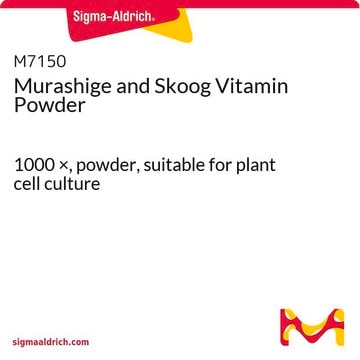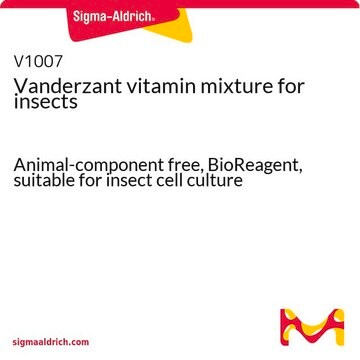S3766
Schenk and Hildebrandt Vitamin
100 ×, liquid, suitable for plant cell culture
Zaloguj sięWyświetlanie cen organizacyjnych i kontraktowych
About This Item
Kod UNSPSC:
12352207
NACRES:
NA.72
Polecane produkty
Postać
liquid
Poziom jakości
masa cząsteczkowa
Mw 180.16 g/mol
stężenie
100 ×
metody
cell culture | plant: suitable
kolor
white
pH
3.25-4.75
Zastosowanie
agriculture
temp. przechowywania
2-8°C
Zastosowanie
Schenk and Hildebrandt Vitamin 100 × (S3766) and Schenk and Hildebrandt Basal Salt Mixture (S6765) are chemstocks that may be used to generate Schenk and Hildebrandt (SH) medium for use in plant cell culture and microproagation.
Ilość
Package prepares 1 L of a 100× solution.
Rekonstytucja
Use at a concentration of 10 mL per 1 L of prepared medium to achieve the proper final concentration.
This page may contain text that has been machine translated.
Kod klasy składowania
11 - Combustible Solids
Klasa zagrożenia wodnego (WGK)
WGK 3
Temperatura zapłonu (°F)
Not applicable
Temperatura zapłonu (°C)
Not applicable
Środki ochrony indywidualnej
Eyeshields, Gloves
Certyfikaty analizy (CoA)
Poszukaj Certyfikaty analizy (CoA), wpisując numer partii/serii produktów. Numery serii i partii można znaleźć na etykiecie produktu po słowach „seria” lub „partia”.
Masz już ten produkt?
Dokumenty związane z niedawno zakupionymi produktami zostały zamieszczone w Bibliotece dokumentów.
Klienci oglądali również te produkty
Sung Jin Hwang
Methods in molecular biology (Clifton, N.J.), 547, 263-273 (2009-06-13)
Hairy root clones of Rehmannia glutinosa were established via transformation with Agrobacterium rhizogenes ATCC15834. To optimize the culturing conditions for both root growth and catalpol production, the effects of various combinations of seven basal media, pH, and carbon sources were
Suk Weon Kim et al.
Methods in molecular biology (Clifton, N.J.), 547, 107-115 (2009-06-13)
This chapter describes culture conditions for high-frequency plant regeneration via somatic embryogenesis and cryopreservation from cell suspension cultures of Ranunculus kazusensis. Zygotic embryos form white nodular structures and pale-yellow calli at a frequency of 84.9% on half-strength Schenk and Hildebrandt
Monya M Costa et al.
Biotechnology letters, 30(7), 1265-1270 (2008-02-15)
Six-year-old Levisticum officinale (lovage) hairy root cultures were used to study the effect of eight different NH(4) (+):NO(3) (-) ratios on their growth and volatile components. All cultures were kept at 24 degrees C on orbital shakers at 80 rpm
Inês S Nunes et al.
Planta medica, 75(4), 387-391 (2009-01-22)
The biotransformation capacity of Levisticum officinale W.D.J. Koch hairy root cultures was studied by evaluating the effect of the addition of 25 mg/L menthol or geraniol on morphology, growth, and volatiles production. L. officinale hairy root cultures were maintained for
Nasz zespół naukowców ma doświadczenie we wszystkich obszarach badań, w tym w naukach przyrodniczych, materiałoznawstwie, syntezie chemicznej, chromatografii, analityce i wielu innych dziedzinach.
Skontaktuj się z zespołem ds. pomocy technicznej







